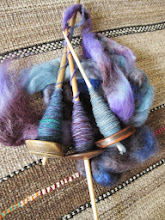Chok – discontinuous supplementary weft
Kit – continuous supplementary weft
(The Lao terms are so much more concise!)
The top weaving shows both types of supplementary weft,
the middle ones are discontinuous (chok) and the bottom continuous (kit).
Traditional Lao weaving incorporates complicated and highly
symbolic patterns in supplementary weft. This means that in addition to the
warp and weft yarns that create the woven structure, an additional set of yarns
is worked in as weft to make the pattern. Because these weft yarns are not
integral to the structure, the technique is called supplementary weft.
The supplementary weft may be continuous or discontinuous.
Continuous weft yarn goes all the way across the width of the cloth: this is
the method when only one color is needed within a row. If many colors are used,
the method is discontinuous supplementary weft, and these weft yarns are
wrapped by hand under the warp yarns, or passed with a shuttle part of the way
across the warp, if the blocks of color are larger. The weaver works with the
back side of the fabric facing up.
In the bottom photo, she has a wide section of discontinuous supplementary weft,
so she passes the shuttle through this section of the warp.
The patterns for supplementary weft are created ahead of
time, and are stored on the loom in the form of a vertical heddle system. This is a set of nylon yarns that are ‘woven’
in the same pattern that will appear in the textile.
The ‘warps’ of this system
are actually heddles, each one holding one of the actual warp yarns of the
piece on the loom. The nylon ‘wefts’ are loops, which are attached in place
above or below the working warp. The loops are hung on a frame with nails
above, and slipped onto posts below.
In this manner, each of the nylon weft loops holds the place
of a pattern row, with respect to the
heddles. The weaver uses the loop to separate the vertical heddles back and
front, bringing the necessary heddles for the current row forward. These
forward heddles are grasped and raised by hand, and the sword is inserted under
them, establishing that pattern row. The supplementary weft is passed, or wrapped by hand, with the sword holding the pattern heddles up. Then the sword is laid flat and the plainweave heddle, operated by foot pedals, is opened and the plain weft is passed.
In the case of continuous supplementary weft, the weft is passed twice for each pattern row, alternating with a pass of the plain weft. Discontinuous weft is only inserted once per pattern row, but more strands of weft yarn are used.
The sequence of weaving is thus (with images from my half-day weaving class, as well as the weaving workshop):
- select the next loop of pattern storage from the vertical system above the working warp
- use this loop to separate the vertical heddles, back and front
- remove the loop and replace it between these heddles, below the working warp (my teacher, Euay Jan, helps keep the vertical heddles separated for me.)
- lift the heddles that have been brought forward and insert the sword under them
- open the shed with the sword and pass the supplementary weft
- close the sword shed without removing the sword, open the plainweave shed and pass the plain weft shuttle
- if this is continuous supplementary weft, open the sword shed again and pass the supplementary weft once more, then the plain weft once more
When the weaving pattern reaches a
mirroring point, the pattern loops are taken from below the working warp and
moved above, to create the reverse sequence of pattern sheds. So at any given
point, you may see a weaver taking from above and storing below, or vice versa.
Understanding how to use the vertical heddles in the right sequence is another
aspect of the weavers’ expertise: the system is not a complete
‘pre-programming’ of the pattern.
This is the reversal or mirroring point of my weaving in my class. After this, I worked my way backward through the stored pattern heddles.
Hoping this sheds some light on the process. It's fascinating to watch, especially the hand-wrapping of the discontinuous weft. The weavers working this way have bundles of color hanging next to them, from which they choose the necessary colors (an excuse for two more pretty photos.)

























6 comments:
Oh. My. Word. What a sensible way to make - and store - complex patterns. I will come back to this again, because this technique might be the best technique to use in my long-term project to weave damask on my ordinary floor loom. I knew I'd need additional heddles to create the pattern, but the idea of STORING the pattern with the weft loops had never occurred to me. Thank you - and the weavers with whom you are studying!
So glad you're benefitting, Sarah!
Another note is that the 'old way' to do this storage is simply to put bamboo sticks in the warp itself, and use them to retrieve the pattern sheds. Problem is, it only works for one piece/pattern at a time, and cannot be re-used like the vertical heddles.
Absolutely fascinating! Great photos and explanation, but still hard to get my mind around. I would love to see this in action, and of course the fabrics are gorgeous!
How do they store the pattern heddles and then use them again later? I can't imagine that after all that intricate work to create them that they pull the strings or sticks out. Do they leave in a good length of warp, weave in lease sticks and then come time to use them again, tie new warp onto the old warp?
hi there
beautiful patterns.
thanx:::
Post a Comment